“The Maquis, Part I”
Written by Rick Berman & Michael Piller & Jeri Taylor and James Crocker
Directed by David Livingston
Season 2, Episode 20
Production episode 40512-440
Original air date: April 24, 1994
Stardate: unknown
Station log: A Cardassian freighter, the Bok’Nor, is docked at one of the upper pylons. A Starfleet engineer named Samuels futzes with a control panel after all the Cardassians board it. As the freighter disengages from the pylon, it explodes, with no survivors. O’Brien and Kira examine the wreckage for signs of sabotage, but it’s Dax who figures it out from a reading she got before the explosion: a protomatter implosive device. But proving that that’s really what it was will take time, and Sisko has admirals crawling up his ass. What’s really weird is that there’s been absolutely no response from the Cardassians.
Sisko has called in Lieutenant Commander Calvin Hudson, who’s both the Starfleet attaché to the colonies in the new Demilitarized Zone, and also one of Sisko’s oldest friends. Hudson also lost his wife, and they exchange stories about Jake, about Dax, and about any number of other things before getting down to business. Hudson feels his job is a joke, and he’s angry that the Federation just abandoned their colonies to the Cardassians, especially since Central Command is doing nothing to protect them. He also thinks it’s just a matter of time before the Cardassians respond to the Bok’Nor’s destruction.
Samuels, now in civilian clothes, meets with Sakonna, a Vulcan woman, who says that quarters have been arranged for him until his ship is ready to leave. On his way to those quarters, he’s abducted. Sakonna meanwhile meets with Quark. She has a business proposition, which they agree to discuss over dinner.
Sisko finds Dukat in his quarters, having come onto the station in secret. He’s there unofficially to help Sisko find the truth—because Dukat already knows it, or so he claims. He accuses Federation citizens of sabotaging the Bok’Nor—or, rather, former Federation citizens living in the DMZ. Dukat knows that Sisko won’t take his word for it, so he asks Sisko to take him in a runabout to the DMZ—“not so demilitarized,” Dukat comments. To prove the point, they find two Cardassian ships attacking a Federation merchant vessel—a violation of the treaty on the Cardassians’ part. Dukat is as surprised as Sisko to find Cardassia violating the DMZ, but the ships are refitted shuttles that Dukat theorizes belong to the colonies in the zone, not the military. The Cardassians do not respond to Dukat’s order to disengage, nor his threat to fire on them, even though he gives them his security code.
Then a Federation civilian ship shows up, also a kitbash of some kind, as it has photon torpedoes, which it fires on the Cardassians, destroying them both. Dukat sadly points out to Sisko that, without any help from Starfleet or Central Command, they’ve started their own little war in the DMZ.
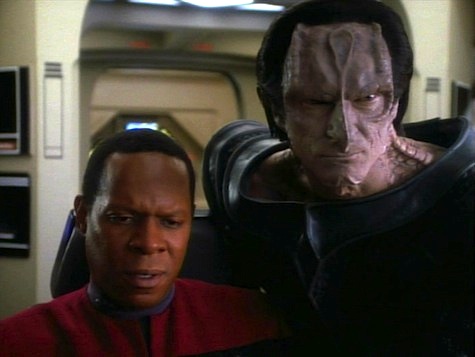
Quark has prepared a feast for Sakonna to commence their business relationship (which has less to do with business and more to do with the fact that Sakonna is hot), which turns out to be far different from what Quark was expecting from a Vulcan: she wants weapons, lots of them, in continuous supply. Sakonna also admits to Quark that she finds him intriguing, which sends Quark’s hand right to his lobe…
Sisko and Dukat arrive at a rather contentious meeting on a colony between Gul Evek and Hudson that includes colonists from both sides. The Federation colonists, led by a man named Amaros, insist that there are no organized Federation terrorist activities, as Evek claims—but then Evek provides a confession from Samuels, who has admitted to being part of an organized Federation terrorist group that is targeting Cardassians, and to destroying the Bok’Nor. When Hudson asks to speak to him directly, they bring in his body, Evek claiming that he committed suicide in his cell. This leads Amaros to attack Evek. Dukat pulls Evek away while Hudson pulls Amaros away, and everyone goes to their separate corners.
Hudson tells Sisko that Samuels was a farmer who didn’t want to give up his land to the Cardassians. But the Federation citizens who stayed behind are being harassed, attacked, assaulted, and worse. Hudson claims not to know of any organized terrorist activities on the part of the colonists, but he also admits that if they are, they probably didn’t think they had any other choice. Hudson also insinuates that the Bok’Nor may have been carrying weapons to the Cardassian colonies in the DMZ, but Dukat pokes holes in that theory on the trip back, especially since the freighter’s route didn’t take it anywhere near the DMZ. Besides, Samuels still killed 78 innocent crewmembers on that ship.
Dukat swears on the lives of his children that there were no weapons on the Bok’Nor. Sisko, for his part, is surprised to learn that Dukat has children, and Dukat says that he has seven. When they return to the station, O’Brien verifies that it was a Federation device that was used, which Sisko already knows thanks to Samuels’s confession.
Sisko tells Kira that there’s no threat to Bajor, as the attack was definitely made by Federation colonists. Kira, in turn, tells Sisko that the Cardassians are not to be trusted, that they will circumvent the treaty in any way they can.
Sakonna and a fake Starfleet security guard lure Dukat out of his quarters, where he’s kidnapped by Amaros.
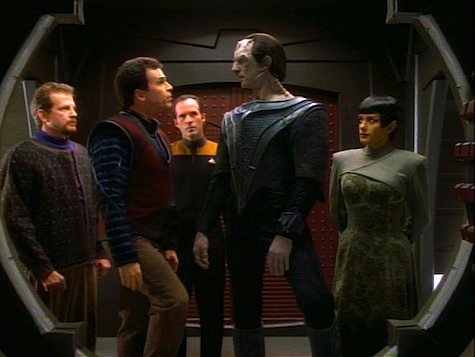
After Sisko has a loud conversation with an admiral, he storms out and tells Odo to review all security procedures. Only two ships left the station in the night when Dukat was taken: one went through the wormhole, the other is quickly determined by Dax to be a fake. A group that calls itself the Maquis claims credit for kidnapping Dukat—and now we have organized terrorist activities among the colonists, just like Evek said.
Sisko takes Kira and Bashir in a runabout to track the other ship, which is discovered heading to the Badlands, an area on the Cardassian border filled with nasty-ass plasma storms. They track the ship’s warp signature to a planet that has human life signs. As soon as they beam down, they’re ambushed by a group of colonists, led by Hudson in civilian clothes.
To be continued….
The Sisko is of Bajor: Sisko and Hudson are old friends, and the two of them, and their wives, did a great deal together, particularly when they were assigned to New Berlin. The Mazurka Festival was a favorite time; Hudson recalls how hilarious Sisko looked in lederhosen, and Sisko comments that he still has the hat.
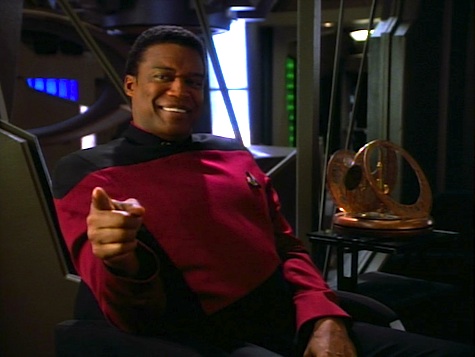
Don’t ask my opinion next time: After Sisko spends more time with Dukat than is probably healthy, Kira gets to be the antidote, pointing out that she lived under Cardassian rule for 26 years, and she knows just how much they suck at keeping their word. She also takes some relish in telling Sisko just how naïve she thinks the Federation is, which prompts Sisko to open the door, making it clear that she’s being kicked out of the office.
The slug in your belly: Hudson hasn’t seen Dax since the symbiont moved from Curzon to Jadzia. He’s taken aback by Dax’s new host to say the least. Hudson was alongside Sisko for a lot of the shenanigans he got into while Curzon’s adjutant.
Rules of Acquisition: Quark quotes Rule #214 to Sakonna: “Never begin a negotiation on an empty stomach.”
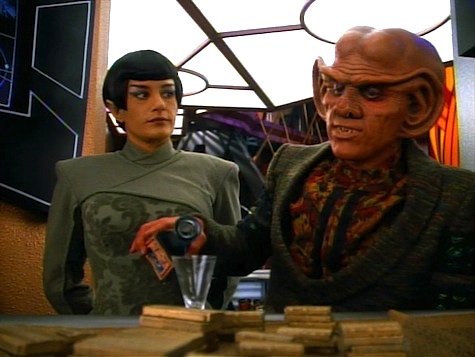
For Cardassia! While the Federation has protected Cardassian colonies that are now in Federation space, the same cannot be said for Federation colonies that are now in Cardassian space.
Dukat claims that the Cardassian education system is the best in the quadrant, though Sisko mentions mental training that starts at age four that takes all the joy out of growing up.
Preservation of mass and energy is for wimps: Odo insists that ships being blown up and people being kidnapped wouldn’t happen if he could have the security he wants: curfews, more deputies, more searches. Kira points out that that would make the place just like it was under the Cardassians, to which Odo replies that things were safer then, to which Kira retorts, “Unless you were Bajoran.” Odo doesn’t really have an answer for that.
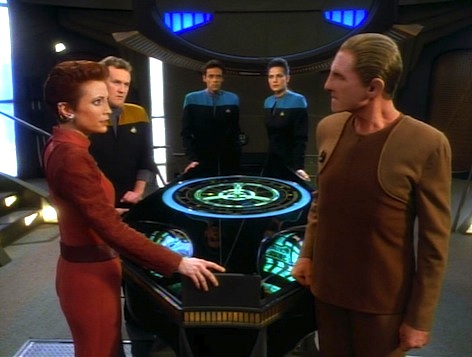
No sex, please, we’re Starfleet: Quark hits all over a mostly uninterested Sakonna, while Hudson asks Sisko if he’s involved with Dax now that she’s a hot chick (and also comments that she knows more about him than any woman, including his wife), and Jake and Nog are sitting on the Promenade watching Bajoran women disembark.
Keep your ears open: “Education is power. Joy is vulnerability.”
“What?”
“Your reaction surprises me, Commander. I thought you would understand. Of all the humans I’ve met, you strike me as the most joyless and the least vulnerable.”
“I am when I’m with you.”
Dukat and Sisko getting to know each other on the runabout.
Welcome aboard: Lotsa guests in this one, from veteran character actor Tony Plana as Amaros, to Bertila Damas as Sakonna (she’ll be back as a Bajoran-turned-Borg in Voyager’s “Survival Instinct”), Michael Krawic as Samuels (he’ll be back as a Caatati in Voyager’s “Day of Honor” and a Vulcan in Enterprise’s “Carbon Creek”), Michael Rose as Niles, and Amanda Carlin as Kobb. Marc Alaimo is back as Dukat, and Richard Poe makes his third appearance (following “Playing God” and TNG’s “Journey’s End”) as Evek; he’ll be back in “Tribunal,” in TNG’s “Preemptive Strike,” and in Voyager’s “Caretaker.” In a nice continuity touch, John Saint John, who was a member of the tribal council in “Journey’s End,” shows up as a colonist (and Maquis member) here. And finally, former pro football player Bernie Casey appears as Hudson. Casey, Plana, Damas, Rose, Carlin, and Alaimo will all be back for Part 2.
Trivial matters: This continues Trek’s first ever true multi-series story arc, set up in TNG’s “Journey’s End,” with the establishment of the Demilitarized Zone and the ceding of Federation colonies to Cardassia. It continues here with the creation of the Maquis—all of this was done to set up the status quo for Voyager’s premiere episode “Caretaker” of Starfleet chasing the Maquis. The storyline will continue in “Preemptive Strike” on TNG and “Caretaker,” and also recur throughout DS9’s third, fourth, and fifth seasons.
The Maquis is named after the French resistance group from World War II.
This episode also establishes the existence of the Badlands, which will be the location of Voyager’s disappearance in “Caretaker.” Sisko prophetically says in this episode that lots of ships have been lost there. The first shot of a planet in the Badlands is far more subdued than we’ll see in the future, with just some discoloration of the space around the planetoid on which Hudson and the gang are hiding. Future portrayals will be somewhat nastier.
The Badlands will be seen in numerous episodes of DS9 moving forward, and also be seen in a great deal of the tie-in fiction, most notably in Susan Wright’s two-book series The Badlands, which includes the origin of the region in the 23rd century involving Kirk’s Enterprise, as well as encounters by the TNG, DS9, and Voyager crews, the latter including the Maquis in some of them.
Some other tie-in fiction featuring the Maquis includes Rogue Saucer and Double Helix: Quarantine by John Vornholt; Wrath of the Prophets by Peter David, Michael Jan Friedman, & Robert Greenberger; A Weary Life by Greenberger, part of the Slings and Arrows eBook miniseries;and your humble rewatcher’s The Brave and the Bold Book 2.
This is the first of several episodes to mention Captain Boday, the Gallamite freighter captain with the transparent head. We will never actually see Boday, or any other Gallamites, onscreen, which is probably for the best, though one does show up in the Starfleet Corps of Engineers two-part eBook Invincible by David Mack & Keith R.A. DeCandido (where we kept him in a hat for the whole story).
One of Sisko and Hudson’s early adventures with Curzon Dax was seen in the short story “The Music Between the Notes” by Steven Barnes in the anthology The Lives of Dax.
Part of Quark’s feast for Sakonna is plomeek soup, a Vulcan delicacy first seen in “Amok Time” on the original series.
Sisko refers to the Cardassians’ arming of Bajoran extremists through the Yridians, though he really meant the Kressari, as revealed back in “The Circle.”
Walk with the Prophets: “One disaster after another keeps bringing us back together again.” Ah, 1994. A heady time. TNG was coming to an end, with a movie series as its next step, and a new Trek show was going to kick off a new network, as the plan was to launch UPN in early 1995 with Voyager, a show that would have built-in conflict with a Starfleet crew and a Maquis cell having to integrate in order to get back home.
To set all this up, both TNG and DS9 devoted a pair of episodes apiece to setting up the status quo that would lead to Voyager going into the Badlands to chase Chakotay’s Maquis cell. (TNG even used the conflict to help spell the end of two recurring characters’ Starfleet careers.) It was almost for naught: TNG went off the air, and aside from occasional lip-service (and one late-first-season episode) Voyager pretty much abandoned the entire crew-in-conflict notion (despite it being a major component of the pre-release hype for the show).
However, DS9 would actually take the Maquis and run with it, making it an excellent running subplot over stories in the next three seasons.
Having said that, the setup here is pretty much just that: setup. Aside from the last-second revelation that Hudson is part of the Maquis—which isn’t a huge surprise, given how he’s actually been bitching and moaning about the Cardassian treatment of colonists and the Federation abandoning them all episode—there’s no real payoff here. The treaty is just as (realistically) stupid here as it was in “Journey’s End,” only the violence that was limited to a single planet in the TNG episode has now escalated to the entire DMZ.
Where the episode shines is in various conversations:
The talks between Sisko and Dukat reveal new layers to the latter character. He’s still an oily, skeevy asshole, and in case we forget that, we have his insistence that it be Starfleet security who escort him on the station, rather than Bajoran Militia. But he’s also something like a voice of reason when Sisko starts proposing Hudson’s conspiracy theories regarding the Bok’Nor (even though we remember all the way back to “The Wounded” on TNG that we’ve seen Central Command pull this nonsense before). Revealing that he’s also got a family adds some depth, particularly in the way it forces Sisko to see him as a person rather than an opponent.
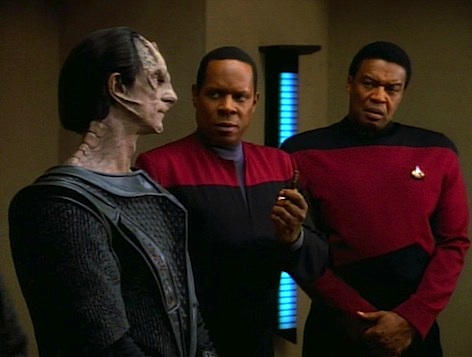
Kira and Odo’s back and forth on the subject of security restrictions is a nice, refreshingly subtle take on Benjamin Franklin’s oft-quoted line about how giving up liberty for security gives you neither.
Quark and Sakonna’s conversations are fun, if a bit lacking. Part of it is Bertila Damas’s unconvincing line readings, and part of it is that the spit-take-worthy revelation that she wants to buy weapons from Quark would be more of a holy-crap moment worthy of the bait-and-switch setup (but she’s a Vulcan!) if we hadn’t already seen Sakonna aiding the guy who blew up the Bok’Nor.
And then there’s the old-friend conversations between Sisko and Hudson, which are the only times that the wooden and generally awful Bernie Casey is in any way watchable. When Casey is marveling at how tall Jake has gotten or reminiscing about Sisko in lederhosen, he’s relaxed and fun, but the minute he starts going on about bad treaties and Cardassian duplicity, his line readings turn stilted and his emotional beats suddenly unconvincing.
As part of the growing development of Dukat as a character, and as a setup for a running subplot, this isn’t bad, but there’s not a whole lot of there there. It doesn’t help that the entire episode consists of our heroes observing and watching and commenting, but not really doing anything.
Warp factor rating: 5
Keith R.A. DeCandido’s next foray into Trek fiction will be The Klingon Art of War, out next spring. First look here at StarTrek.com.




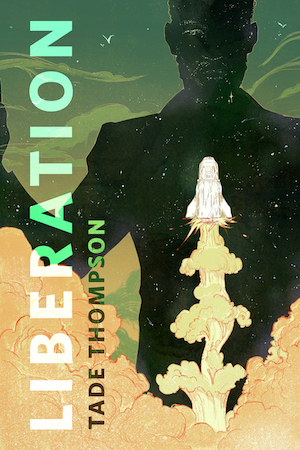





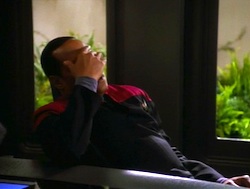
Sisko’s interactions with Hudson and Dukat are by far the best part of this episode. Getting a chance to see him with an old friend is a lot of fun and helps to round out the character a bit. And seeing him sparring with Dukat, disgusted by not entirely unsympathetic, is wonderful.
I continue to remain pretty uninspired by the plight of the Maquis. I want to be on their side, but I have a hard time really buying the absolute necessity of them staying where they were. I totally get the way this fits with standard earth practices – where borders shift on a map and the actual villages at the margins end up with new tax collectors and new people coming to force you to fight for them. But I would really like to see them establish more coherently why they’re so attached to these planets.
This fits into a larger theme that has characterzed a bunch of early DS9 episodes: people who feel a strong attachment to a particular place and others who want them to leave. The Maquis, Kira’s difficult farmer friend (Progress), the Skrreea (Sanctuary), the anti-technology settlers (Paradise). That’s a lot of variations on the same theme. I have to admit I’m getting a little bit sick of them going back to this well.
I liked this one for the most part, but always found Bernie Casey rather grating. Maybe there are things he’s good at, but he just wasn’t suited for the style of dialogue and performance called for by Trek.
This episode begins the process of adding dimension to Dukat and making him more sympathetic — a process that the producers would later decide they’d taken too far.
And yes, it is a choice irony that the Maquis backstory created to set up Voyager ended up being used more on DS9. But really, what did they expect? Why create a complex political backstory rooted in the Alpha Quadrant if their intent was to have the whole series take place on the other side of the galaxy, where the whole thing was rendered irrelevant? I have to wonder why they thought that was a good way to go. Now, if they’d had a Cardassian crew pulled into the Delta Quadrant and forced to serve on the same ship with the Starfleet and Maquis crews, that would’ve made better use of the background. (I actually wrote a VGR spec script called “Demilitarized” where they encountered Cardassian refugees. It never got anywhere, though.)
As a first time watcher (although I could tell where this was going to go, based on having seen the TNG episodes), I enjoyed it. Yet, I find myself strangely conflicted. I totally empathize with the Maquis here, and maybe they’re even justified in defending themselves (although I really can’t condone terrorism). The Cardassians certainly are not upholding their end of the treaty. It’s not hard for me to understand why they wouldn’t want to uproot and move.
I also have to remind myself that Gul Dukat is the bad guy here, the one formerly in charge of the station and the Bajor occupation. He’s probably lying through his teeth about most things and wouldn’t hesitate to throw the Federation under the bus if it suited Cardassia.
Because, honestly, I think he’s kind of awesome. I WANT him to be one of the good guys! I want there to be an alternaverse where he and Sisko go around kicking ass and taking names.
I can’t even pin down exactly why I feel this way, I just do. :)
Unrelated side note. This week is the annual users group meeting at the software company I work at. Every year there is a theme, this year it’s ‘Deep Space’, which lends itself to lots of science and sci-fi jokes and references. Before are big general executive session, while we were waiting for everything to begin, they played the Deep Space Nine theme on the organ (along with TNG and the TOS themes). I felt all warm and fuzzy ;)
This episode sets up part 2, which is where we really start to look at the idea that not all of the Federation is paradise, although we get some glimpses of that attitude with the less than arms wide open reception from the Bajorans and Jake nt wanting to go into Starfleet. Actually I sort of like the idea that these settlers sort of identify more with the planet that they live on more than the giant interstellar federation they belong to.
Bernie Casey was very distracting except for the scene where he and Sisko talk about how settlers don’t leave their houses alone at night and how the Cardassian Authorities are as much instigators as any thing else. Maybe because we just had the 50th Anniversary of the march on Washington, or maybe because it was two African American actors, but that same scene could have been about any group not in power: blacks in the south, apartheid in South Africa, Jews in Eastern Europe. It was such a powerful scene about the idea of not feeling safe in the place you call home.
To me the maquis story is where ds9 really starts to set itself apart from the rest of trek because of the reoccurring story arc- simply put it is an arc that can only be done on a show that doesn’t warp around space. Up to now much of DS9 shows could have been TNG shows, but not this one. I love that the maquis arc, and the Klingon arc, and the Dominion arc all shake up the trek-verse and let us see a darker federation.
@@.-@: I’ve said before that Joss Whedon’s Firefly is a lot like what a Trek-universe series told from the Maquis perspective would be like. Audiences have the impression that FF’s Alliance is a stock Evil Empire, because decades of genre film/TV have conditioned audiences to expect stock Evil Empires in space opera, but Whedon’s intent was always that it was no better or worse than any federal government, that it was even quite beneficial for those who fit into society (like Inara), but it looked more threatening from the perspective of libertarian types or people on the fringes who didn’t want to give up their frontier ways, and it had the capacity for the corruption and abuse of its benevolent intentions, as seen in the movie. The Maquis are the frontier types who aren’t content to assimilate into the mass of the Federation, and who see the UFP as a more malevolent and threatening force because it failed them. And even the UFP has its corrupt elements, as we’ll see as DS9 continues.
When Ifirst saw this, it never dawned on me this excellent crossover story arc was setup for the new Star Trek series. I just saw the whole thing as an intruging story of higher-ups making terrible (but realistic) decisions affecting ordinary citizens and the fallout, especially since by the time Voyager premiered, it was clear from the beginning that the Maquis backstory would be just that, a backstory. Nothing major was ever done with the Maquis subplot on Voyager, so that was my takeaway then, and still now.
Having said that, this two-parter is always exciting to watch. Its just too bad our main characters really just stood around and talked for part one. I always enjoyed watching Sisko and Hudson laughing while catching up, and can’t help but laugh myself. Its a solid hour that’s a good setup for the next part and later episodes (even though we don’t see Hudson again after part two).
@2: I’ve always thought Voyager would have been a stronger series if “Caretaker” has been the second season premiere.
For the first season, do a Next Generation-lite, with Janeway and her crew hunting down the Maquis along the Badlands. Chakotay is a recurring guest star throughout the first season, and the audience gets to know him as a villain. At the same time, we get to know the characters that Janeway will lose when the Delta Quadrant thing happens, so that when the characters are lost the audience feels the loss and when Janeway decides to ally with Chakotay and his Maquis crew it feels like a bad bad thing.
I really liked this one. I thought the Quark/Sakonna and Sisko/Dukat interactions were great.
@8, you’re completely right – that would have been a GREAT start to Voyager. Sets the stakes a lot higher, apart from the “we’re never going to get home, but we’ll be making our way in that general direction and have some adventures along the way.” Cause you know at the beginning that they will eventually get home. Along those lines, Stargate: Universe did a MUCH better job of setting up that journey.
But back to DS9: what’s the time frame between the two TNG episodes and these two episodes and Caretaker? I kind of want to go back and watch them all in order now.
Also, I know that Voyager connects with the Alpha Quadrant at some point, but my memory is fuzzy. Does it make sense to watch Voyager Season 1 along with DS9 Season 3 and continue on from there?
scinatfilm: Start with “Journey’s End” on TNG, which is where the new treaty’s terms are first seen and the consequences played out. Then this two-parter, then “Preemptive Strike” on TNG, “Tribunal” at the end of the second season of DS9, then “Defiant” in the third season of DS9, then “Caretaker,” the Voyager pilot.
—Keith R.A. DeCandido
I generally enjoyed the Maquis arc, though they could have done a better job of meshing it with the Dominion War. The quality of the stories also drops off toward the end. Still one of my very favorite moments on DS9 is the justification speech by a certain recurring character who turns out to be a Maquis mole. (The other mole was a huge mistake, IMO, and led to, or may have been the result of, conflicts between cast and producers.)
Giving Dukat depth was also a terrific step. For a good long while, there’s a sense that he’s not too terrible as Cardassians go and that he and Sisko might even be able to work together productively. Of course, circumstances ultimately smash that, but there too the depth he’s been given make his choices all the more interesting.
Voyager did sort of run with the crew conflict thing for a while. Sure, most of is was “B’Elanna has trouble with protocol and procedure” type stuff, but there was also an undercurrent of distrust. The thing with Chakoty’s former second in command/girlfriend running off to join the feather-headed bad guys never really worked and was wisely dropped, not least because it was a little too reminiscent of the original BSG. And really, after the first season, those people had been working together for a while and gotten to know each other. Continuing conflict would have become less and less plausible.
Regarding Sakonna – her responses were confusing. If she was a wet behind the ears newcomer to off-Vulcan business, I might have understood her confusion as so many things. But the Vulcans strike me as, if anything, prepared and unflappable. Here, it was like she had neer heard of the Ferengi and was going into business without understanding who she was buying from? What if Quark was a Cardassian sympathizer?
I also don’t buy the first colony debate. If Sisko and Dukat don’t show up, what would they have accomplished? Why bring the dead body back? Wouldn’t it have made more sense to say that based on his confession, he was convicted and was serving a sentence? Where did the debating Cardassians come from? Cardassia or the colonies? If the colonies, why would they willingly come to a colony they are at “war” with to debate a skirmish? If Cardassia, wouldn’t Dukat have wondered how Central Command knew about this incident – it couldn’t have been the first time this has happened.
Finally, Bernie Casey. I’m not sure what they wre thinking here. It’s like they wanted Yaphet Kotto and his gravitas, but couldn’t afford him. So they found a black guy of a similar age and build and said, “pretend you are Lt. Giardello on Weight Watchers.” But instead of pulling off thoughtful and deliberate, Casey gave them a Shatner parody. Unlike krad and others, I don’t think he managed to pull off a single scene. Still, every time I watch this, I am reminded that Brooks’s “loud=passion” philosophy isn’t really that bad.
The second Hudson showed up on screen, I pointed to him and said “That guy’s a Maquis.” So naturally I got a good laugh at the big “reveal” at episode’s end.
Casey might have pulled off the scenes where he and Sisko were telling their glory days stories, but the rest of the time I kept expecting him to be offering Bashir a membership in the tri-Lambda fraternity.
I think the real problem Voyager had was not that they didn’t want to do a longer story arc (heck, “how do we get home?” could be considered a long story arc for the whole show), or that the writers didn’t know how to do longer arcs (DS9 was right there to show them), but that Voyager was considered the flagship show of the entire UPN network. As a result, it was subject to more executive interference than DS9. With long-form storytelling being new to TV at the time, and with TNG just having been very successful doing self-contained episodes for years, it’s understandable that Voyager was pushed in that direction.
The shame of it is that they tried to split the difference. If you want self-contained episodes and a good flagship series, just do another TNG-type series. Creating an interesting setup with dynamic characters and potential for long-running plots, and then abandoning that setup, is worse than not doing it in the first place.
Rancho Unicorno: OMG, Yaphet Kotto as Cal Hudson would’ve been SO TOTALLY AMAZING! And I doubt that affording him would’ve been a problem given that, at the same time this episode was being made, Kotto was a star on Homicide: Life on the Street, a show with about a tenth of the budget of DS9.
—Keith R.A. DeCandido
@@@@@ CLB… I never thought of the maquis as the brown coats from Firefly, but it’s a pretty good comparison. Being transferred to the Cardassians like property was probably too much for the settlers to take, so why not strike out on their own.
As far as Voyager goes, it should have actually resembled BSG more than TNG. Here’s a ship that spends 7 years in the Delta quadrant, without resupply or reinforcements. Fights numerous brand new enemies including the Borg, goes through multiple “years of hell” (Yes, I know they got chronologically erased), and in general are in a constant fight for their life and they return to Earth just as shiny and brand new looking as they day they left Spacedock? Really? A few dents, broken pieces and smudges on the paint would have done wonders to sell how hard of a time they were having.
And lastly I agree with the producers to give Dukat some serious depth. The fact that he had some facets to him that were likeable made him the primary nemesis for the DS9 crew for 7 years- if he was just evil we would have gotten sick of him after a while. But you have to like that he has passion for what he thinks is right (Cardassian nationalism and values) and that he fights for it. He’s not humerless, he’s not just out to get people, and he does at times genuinely seem remorseful of some of his past actions. We get just enough of a tease that “Dukat’s not so bad” and then he does something dickish to remind us that, yes, he really isn’t a good guy. But nowhere else in Trek, and very few other places in television at all do you get a series run villain who doesn’t feel stale.
@18: Voyager‘s ability to repair itself and build new shuttles never bothered me, because, hey, they’ve got replicators! As long as they have power and raw materials, they can manufacture anything. Power can be harnessed from any star, and there are plenty of those lying around, and raw materials can be mined from the countless asteroids and comets that can be found around any star and probably in interstellar space too. If anything, the implausible episodes were the ones where they did run out of stuff — notably “Demon,” where they ran out of deuterium, one of the most abundant resources in the universe. (The writer intended it to be dilithium, but the producers threw logic and physics out the window because they thought it would be funny for the ship to “run out of gas.”)
But I would’ve liked more exploration of the consequences of events on the characters, more progression of life aboard ship. Why were all the relationships so static save for Tom and B’Elanna? These people were stuck with each other for the rest of their lives as far as they knew. They should’ve been pairing off and having kids. There should’ve been real disputes over whether to keep moving on or settle down on a planet, and some people should’ve chosen to stay behind in “The 37s.”
@krad – I agree. I rewatched it again last night, an mentally replaced Casey with Kotto (Casey being as forgettable as he is, it wasn’t too hard). The episode became twice as good – maybe even one of the most solid of the season. At the very least, it didn’t feel like Cal was reading his script for the first time as they filmed.
I hadn’t thought about the budget differences between the criminally-underappreciated-and-even-better-than-The-Wire-but-what-were-they-thinking-with-Season-7 Homicide and DS9. My assumption was that the budgets were not too far apart and Kotto’s lead role money would have made him too costly for a guest appearance. With the minimal time commitment that would have been required, now I’m even more bothered that they didn’t bring Kotto in.
It’s always a sad day when I’m reminded that Mr. Yaphet Kotto isn’t in something.
@8: I can’t say that I think it would have been a great idea to have an entire season of Voyager take place before they were lost in the Delta Quadrant, just because if they did, then “Caretaker” could have ended up feeling like an abrupt change in premise. Now, a couple episodes, or a miniseries, maybe? You could totally sell me on that.
@2: Yes, having a third (ish) of the crew be Cardassians would have been a GREAT way to capitalize on the Maquis plot thread. Then, even after you have the various sides start to work well with each other, you can always reveal in season 3 or 4 that one of the crew was behind the bombing of another crew member’s wife’s ship or something, and renew the tensions all over again.
@19: Voyager‘s crew being able to repair the ship over time makes enough sense, but it would have been great if, the episode after a fight, they made a point of showing how they still had a hole in the ship and needed to hunker down somewhere safe before they could fix things up. They could even have, at points, deprived the crew of the chance to find a safe spot, being forced from one conflict to another. That could have helped prevent the feeling that Voyager just had a reset button that got pushed the second the closing credits started.
(Though, replicators notwithstanding, I always thought it would have been neat if Voyager had ended up becoming a Frankenstein’s monster of ships: the nacelles don’t match, the hull is a mishmash of colors, etc., because they’d been forced to use whatever spare parts they found along the way. Maybe even if, during “Caretaker,” both Voyager and Chakotay’s ship were so badly damaged that they needed to take parts of both to make what was left workable.)
Another thing I also thought would have been great for Voyager would have been if they’d assembled a small fleet of allied ships over time. I believe your Myriad Universes story had something similar going on, with the crew establishing an outpost of the Federation in the Delta Quadrant? In fact, your story had a lot of moments where I thought, “Oh, if only the show had done this!” ;)
-Andy
@21: I’m sure the producers wanted to have the kind of continuity where damage sustained in one episode carried forward into others, but UPN wouldn’t hear of it. They finally got to do it in Enterprise, though, in “Minefield”/”Dead Stop” and in much of season 3.
The worst reset-button example I can think of was after “Investigations.” In that episode, Voyager‘s warp coils were severely damaged and rendered useless until new materials could be obtained to rebuild them, but the planet they went to in order to obtain those materials was a Kazon trap and they had to retreat. So they were still completely devoid of warp capability at the end of that episode, with no evident way to get the engines repaired. But next week the warp engines were back to normal! Whaaaaaaaa?????
And yes, for me, writing Places of Exile was basically an extended exercise in “Oh, if only the show had done this!”
@3 and others: Yeah, I think Dukat’s characterization is one of the most interesting, most powerful, most impressive things about DS9 as a series. He’s truly a multi-dimensional character, one that you WANT to end up as a good guy, even though he is more of a morally gray “neutral” alignment.
And his development through the later seasons of DS9 (I won’t post spoilers here) just makes this early complexity all the more poignant.
@23: But the problem with calling Dukat morally neutral is that he was the guy in overall charge of the brutal exploitation, enslavement, and mass murder of the Bajoran people. Dukat’s charm goes to illustrate how the architects of great evil are usually not obvious cackling villains. Most of the people responsible for the Holocaust were probably nice enough in person and kind to their families. Even Hitler was kind to animals and reputedly could be charming in person. But some actions and choices are so horrible that no amount of otherwise decent behavior can tip the scales even as far as “neutral.”
@21, I’m pretty sure that the Challenger ship in the novels was a frankenstien ship along those lines. It was one of the more interesting parts of the premise. The “make do with what we have, out on the frontier” aspect was good fun.
Oh, and sorry for the double post, but I’d call Dukat “Affably Evil”. There’s a TV Tropes article on that one. He’s a villain, he’s just an agreeable one.
Count me in as part of the camp that liked Dukat and wanted him to stay helpful and make amends – or at least be a more noble foil for the good guys. Dukat’s charm came from Marc Alaimo and his popularity even surprised the producers. I could be convinced that his reign over Bajor was just him having to make the best of a crappy situation. Perhaps he was actually lenient on Bajorans compared to how his comrades wanted to treat them. Whenever he tried to ease up on restrictions, even more terrorist attacks took place. What else could he have done? I also admit that promoting that idea was part of his self-deluded nature and narcissistic desire to convince everyone that he’s a good person.
@27: Yes, Dukat thought he was being kinder than his peers, but he still saw the Bajorans as inferiors, as children who had to be ruled and disciplined, and that was what enabled him to justify the atrocities he committed. We’ve seen similar patterns in real-world history, such as the massacres and oppression the British imposed on the people of India as part of a policy that was nominally meant to “civilise” and “elevate” the Indians for their own good, but was really about institutionalizing them as a subordinate class on the grounds that they were incapable of taking care of themselves.
@27, yes, Dukat did say that, and maybe he even believed it: but in several seasons’ time, in _Waltz_, it’ll become clear that deep down he really didn’t think that at all.
I may be misremembering here, but didn’t the colonists on the other side of the border become Cardassian citizens when the treaty was signed? In this episode, they are continually referred to as Federation citizens. I might be totally wrong.
@30: Yes, they were meant to become Cardassian citizens. As for this episode, they’re only called “Federation colonists” rather than “citizens,” which could be taken as an indicator of their origins rather than their current affiliation; but in Part 2, Admiral Nechayev does explicitly call them Federation citizens, and Sisko tells Dukat that they’ll be tried under Federation law when they’re captured. So yeah, that is a contradiction.
Maybe the treaty ended up giving them some kind of dual citizenship? Or maybe the change of citizenship from TNG: “Journey’s End” applied only to Dorvan V, and the other DMZ worlds resisted that solution? I dunno. Funny I never noticed that rather glaring inconsistency.
Much is said about the former Federation citizens under Cardassian rule, where the Maquis come from… but they never mention the Cardassians that are now Federation citizens. Is that ever touched upon in any of the novels? I haven’t read the DS9 relaunch ones, for example.
I loved seeing John Saint John in this episode.
Krad, do you really think this is Trek’s first multi-series story arc? Wouldn’t the Cardassian/Bajoran conflict first seen in TNG that lead to DS9 fill that slot? Of course, this is part of the same thing, but it started back then, didn’t it? Or by “multi-series” do you mean more than two?
My point was that this was the first multiseries plot that was conceived as such. Both the Cardassia/Bajor story and the Klingon political story started on TNG, then moved to other shows later, but the Maquis story was the first one intended as cross-series.
—Keith R.A. DeCandido
Ah, gotcha. Thanks.
I agree with Rancho Unicorno and everyone else who mentioned him that Yaphet Kotto would have been wonderful as Hudson. It’s a shame that he never appeared in Star Trek.
To be fair, GusF, I can’t imagine a role Yaphet Kotto wouldn’t be wonderful in………
—Keith R.A. DeCandido
I was hoping the Trek writers left that “old friend turns up -> it’s the bad guy” plot behind them? The second Hudson walked through the door I said “oh, it was him”. That’s really too easy and takes away lot of fun.
Also, yes: Bernie Casey is painful to watch. If he’s acting out normal, everyday conversation he’s ok. But anything but small talk and it just is awful.
Also, “sausage and beer and Lederhosen” in New Berlin? Maybe they where in New Munich without even realizing it?
Lockdown rewatch. I think I liked this episode better than the general consensus, I think mainly because it’s the first time we really see Sisko and Dukat bouncing off each other, a highlight of the series going forward, the opening back and forth between Kira and Dax in the pre credits is also an absolute joy, Gul Evek is back and the Marquis storyline is a much needed thorn in the side of the Utopian Federation. But, yes the Cal Hudson stuff is pathetically obvious and a major flaw in the plotting.
8: That would never have worked but I do like the idea of Voyager getting home halfway through S7 and we get to see the crew trying to reacclimate to life in the Alpha Quadrant (especially after the Dominion War).
O’Brien mentions the planet “Galador.” I wonder whether it was an intentional reference to the Marvel Comics version of the Hasbro toy turned superhero Rom, Spaceknight.
I love all the scenes with Quark and Sakonna in this two-parter, the highlight, of course, being Quark solving the problem of war with economics in part two. And even though the performance of Bertila Damas is hardly one of the better Vulcan portrayals, I felt the two actors had decent chemistry together. Quark’s disappointed reaction to Sakonna calling him intriguing was interesting. I guess he didn’t realize that a Vulcan finding you intriguing is actually quite a compliment.
This episode, as well as the following one, is one of the worse examples of the “main characters do everything” syndrome I’ve seen in Trek. The DS9 crew knows they’re after a group of violent terrorists, yet when they discover the terrorists’ hiding place, only three people go down there: the commander, the first officer and the doctor of the station. Really? They couldn’t afford to send at least a few security officers to back them up? Of course the Maquis then manage to ambush and outnumber them. And in the next episode it seems they haven’t learned anything, because the rescue team sent to save Dukat again consists of three people, with Odo having replaced Kira. In that case they were lucky that the Maquis turned out to be so bad at aiming their phasers, because otherwise they would’ve been outnumbered again.
I understand that the showmakers want to have the actors billed in the opening credits present in the most dramatic scenes, but Sisko’s decisions here still defy logic. Most other Trek episodes would’ve at least included a couple of redshirts in the team besides the three main characters.